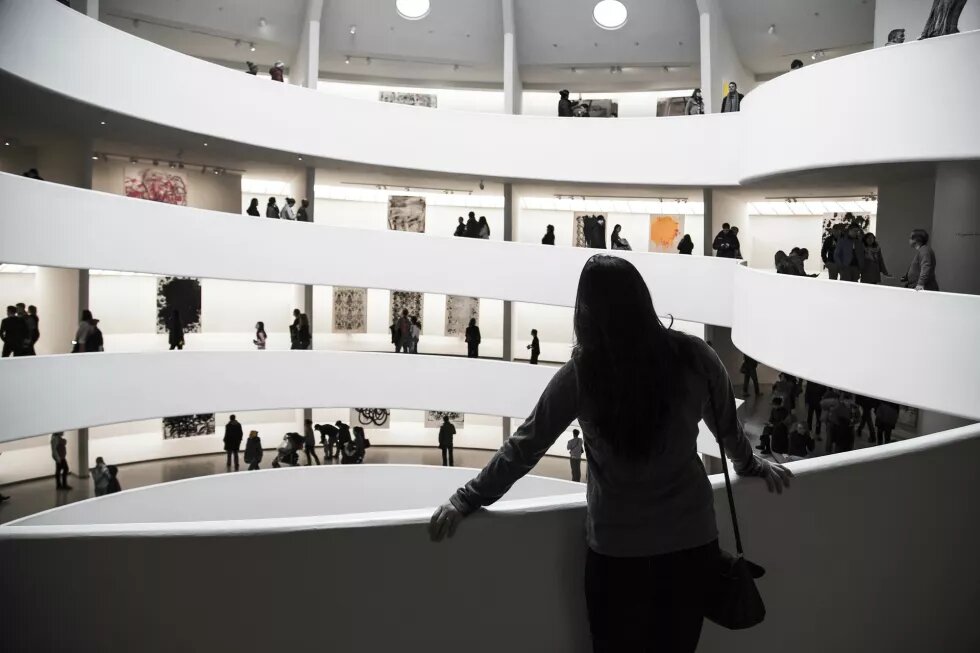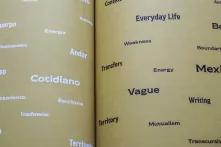"In our mestizaje theories we create new categories for those of us left out or pushed out of the existing ones. We recover and examine non-western aesthetics while critiquing western aesthetics; recover and examine non-rational modes and "blanked-out" realities while critiquing rational, consensual reality; recover and examine indigenous languages while critiquing the "languages" of the dominant culture. And we simultaneously combat the tokenization and appropriation of our literatures and our writers/ artists."
Gloria Anzaldúa (1)

Who decides which artistic works are exhibited in museums? Which artists are invited to festivals and by whom, and who are the curators? And who defines what contemporary modern art is in contrast to, for example, arts and crafts and folklore.
This distinction leads to a classification and categorization of artistic working methods that are closely linked to colonial power structures and the Western understanding of aesthetics. It would also be possible to speak of Othering within the arts: Art forms and artists are separated by a strong power imbalance.
My perception of art is also strongly influenced by the Eurocentric canon of art history; the introductory courses in art history at university were all about the "old (white) masters" from Italy, France and Germany, without critically reflecting on the lack of diversity or why only their works are exhibited in the most influential museums in the world. These museums are of course mostly located in the Global North. For a few years I worked at various city theaters, and there, too, homogeneous ideas about what a production should look like in order to fit into this Western grid of aesthetic understanding, were prevalent. Even today, I still find myself falling into this Eurocentric pattern when I talk about or even judge art, especially when it involves art forms that are new to me. What do I actually find beautiful?
That's why I try to unlearn, dissect and question my previous understanding of aesthetics: where exactly does this understanding come from? And what else is there beyond Eurocentric aesthetics?
Because what is perceived as beautiful in dominant societies of the Global North was constructed as so-called aesthetics during the Enlightenment in 18th century Europe, and according to Walter Mignolo was henceforth to serve as a global, generally valid point of reference: "Modern aestheTics had its point of origination in Europe, it is regional, local, but assumes the right to be ONE universal AMONG other regional and local universals."(2)
Immanuel Kant's definition of beauty, which was coined during the Enlightenment, clearly revolved around the axis of coloniality (3). In his view, aesthetic perception and sensation were a white privilege. In writings such as "Beobachtungen über das Gefühl des Schönen und Erhabenen" (1764), "Von den verschiedenen Racen der Menschen" (1775) and "Kritik der Urteilskraft" (1790), Kant constructed various stages of humanity and became one of the key figures of racial theories. (4) With regard to the linking of these theories with concepts of aesthetics, the philosopher is central, as he combines anthropological, philosophical and aesthetic reflections in his writings. According to Kant, only white people can embody the ideal of beauty. His understanding of aesthetics was closely linked to the concept of civilization. Only those who were civilized had taste and the capacity for perfection. (5)
More than 200 years ago, for example, Kant already shaped the perception of beauty as something that was only possible for white people. To Blacks, especially enslaved ones, he denied the ability "(...) to have presented something great in art and science, or any other glorious quality"(6). His essentialist theories, which were also taken up and continued by other philosophers such as Johann Gottfried Herder, are still present today and make clear how central the invention of human races was to the legitimization of colonialism and how this even influences today's understanding of aesthetics.
Among other things, aesthetic theories were intended to judge and distinguish art, for example, from crafts which were considered primitive. The aesthetics constructed in Europe were to have universal validity and power of judgement and were based on the dualistic separation of emotions and sensations of mind and spirit. (7)
According to Walter Mignolo, the Eurocentric concept of aesthetics served above all to "(...) understand and appreciate the beautiful and sublime, and to determine who was not yet able to attain such an understanding"(8). Here the instrumentalization of the concept and various dimensions of coloniality are evident, since not everyone was given the same degree of ability to possess or acquire an aesthetic sense.
This hierarchization and categorization of art, among other things on the basis of the concept of aesthetics, is not a relic of the past, but continues to exist into the present.
This concept is still used as an argument today. Curators, dramaturgs and artistic directors act as gatekeepers (9) in the cultural sector because they decide which artists meet the respective aesthetic demands. The problem is not only that a few people decide who may show their art, but also that the selection criteria are often still based on a colonial-hegemonic concept of aesthetics.
An example of this Eurocentric aesthetic in current art practice is the ubiquitous White Cube in exhibition spaces, i.e. the idea of presenting art in white spaces. According to Hito Steyerl, the whiteness of the walls should already signal the civilization Kant conjured up. The White Cube serves as a standard for art. The question arises as to what and whom it represents.
"The White Cube does not only define aesthetic guidelines – it functions itself as an aesthetic guideline. By including it in a certain canon, it ultimately also defines what art is. Inclusion in the White Cube not only gives the art an aura of canonization – it ultimately determines its value in the art system. (10)
Particularly in the Global South, critical voices are becoming increasingly loud to deconstruct this concept of aesthetics and the power that goes with it. One such voice belongs to the Colombian cultural anthropologist Adolfo Alban Achinte, who introduced the concept of decolonial aesthetics. As early as the 1980s, Achinte discussed the question of what role aesthetics plays in the colonial power matrix, i.e. to what extent the Western understanding of aesthetics represents and reproduces colonial structures. The aim of the research group around Achinte was to connect the ongoing post- and decolonial discussions with aesthetic debates and practices, because until then this was a blank space in the discussions around decolonization.
Mignolo, who was part of this group, published his first article on the concept of decolonial aesthetics (11) in 2010, emphasizing a non-binary approach of feeling, thinking and acting. He thus positions his concept in contrast to the separation of mind and emotion/ body and spirit that has been common in Europe since the 18th century. Mignolo argues that reason should not be seen as the only way to understand the world, and that this dichotomy should be broken.
Mignolo and his colleague Rolando Vazquez therefore call for aesthetic disobedience to this coloniality of aesthetics, and a first step for the scientists is the transformation of the term aesthetic to aestheSis, since the terminology is already strongly interwoven with coloniality.(12) AestheSis sees this new way of thinking as an intervention within the established art and culture business, which refers to the critique of the colonial power matrix.
AestheSis questions the hegemonic canon and deconstructs the normativity with which art is evaluated and categorized. The body is given a greater role here, because for too long embodied knowledge has been suppressed and given less importance in dualistic thinking. Authors like Gloria Anzaldúa focus on decolonial processes of transformation that go through the body and speak of embodied aestheSis. For the artists Rajkamal Kahlon and Nashilongweshipwe Mushaandja embodiment is also a central artistic and aesthetic practice.
These new, power-critical concepts of aesthetics contribute to the decolonization of the cultural industry. New, decolonial approaches to curating and artistic work are emerging. For example, the projects presented in the anthology "Anti*Colonial Fantasies. Decolonial Strategies" (9): the works of BIPoC artists can be understood as aesthetic interventions against ongoing colonialism and racism within and outside cultural institutions.
The artist and curator Bonaventure Soh Bejeng Ndikung sees the potential in the meeting spaces of art, where aesthetics can be re-thought:
"An art space is a friction zone. An art space must be a place of reflection. A recalibration even of aesthetics.“(14)
The curator Alanna Lockward also generates friction through her project Black Europe Body Politics (15) at Ballhaus Naunynstraße in Berlin. Under the heading of Afropean decolonial aesthetics, new aesthetic approaches of feeling will be developed jointly, which will make visible the hidden coloniality, the art plantations of modernity, and focus on experiences of the diaspora.
The Kantian concept of the beauty is thus shaken, colonial continuity and patriarchal dominance is exposed and deconstructed layer by layer. Aesthetics as the epitome of a tool of white (colonial) patriarchy must be deconstructed. For too long, white men such as Kant, Hegel, as well as (museum) directors have instrumentalized the concept of aesthetics for their own purposes, systematically excluding certain individuals, including women and artists of color. But this is precisely where interventions come in, the sovereignty of interpretation over art and the concept of aesthetics is called into question by them: Guerilla girls intervene with large banners at art fairs, curator Valeria Montoya walks through Mexico City, Nashilongweshipwe Mushaandja performs around an imaginary rubber tree.
Interventions in the coloniality of aesthetics take place in a variety of forms, the previous (art history) canon starts to crumble.
Footnotes:
1 Anzaldúa, Gloria (2017): Haciendo caras, una entrada. In: Keating, AnaLouise (Hg.): The Gloria Anzaldúa Reader. Durham: Duke University Press. 124-139 (137)
2 Mignolo, Walter/ Vazquez, Rolando (2013): The Decolonial AestheSis Dossier. URL: https://socialtextjournal.org/periscope_article/the-decolonial-aesthesi… (02.06.2020)
3 Detaillierte Ausführungen zum Konzept der Kolonialität nach Aníbal Quijano finden sich im Editorial dieses Magazins. / Detailed explanations of the concept of coloniality after Aníbal Quijano can be found in the editorial of this magazine.
4 Siehe auch: Piesche, Peggy (2017): Der ‹Fortschritt› der Aufklärung– Kants ‹Race› und die Zentrierung des weißen Subjekts. In: Eggers, Maureen Maisha/ Kilomba, Grada/ Piesche, Peggy/ Arndt, Susan (Hg.): Mythen, Masken und Subjekte. Kritische Weißseinsforschung in Deutschland. Münster: UNRAST-Verlag. 3.Auflage. 30–39
5 Vgl. Kaufmann, Sebastian (2020): Ästhetik des ‚Wilden‘. Zur Verschränkung von Ethno-Anthropologie und ästhetischer Theorie 1750-1850. Basel: Schwabe-Verlag. 309ff
6 Kant, Immanuel (1764): Beobachtungen über das Gefühl des Schönen und Erhabenen, zitiert nach: Kaufmann, Sebastian (2020): Ästhetik des ‚Wilden‘. Zur Verschränkung von Ethno-Anthropologie und ästhetischer Theorie 1750-1850. Basel: Schwabe-Verlag. 319
7 Vgl. Kaufmann, Sebastian (2020): Ästhetik des ‚Wilden‘. Zur Verschränkung von Ethno-Anthropologie und ästhetischer Theorie 1750-1850. Basel: Schwabe-Verlag. 309ff
8 Mignolo, Walter (2012): Dekoloniale Ästhetik. Das Museum verlernen und wiedererlernen durch Pedro Lasch Black Mirror/ Espejo Negro. In: Bandi, Nina/ Kraft, Michael G. / Lasinger, Sebastian (Hg.): Kunst, Krise, Subversion. Zur Politik der Ästhetik. Bielefeld: Transcript-Verlag. 129–148 (131)
9 Gatekeeper*innen fungieren als Türsteher*innen, sie haben eine wichtige Position bei der Entscheidungsfindung. / Gatekeepers act as bouncers, they have an important position in the decision-making process.
10 Steyerl, Hito (2017): White Cube und Black Box. Die Farbmethaphysik des Kunstbegriffs. In: Eggers, Maureen Maisha/ Kilomba, Grada/ Piesche, Peggy/ Arndt, Susan (Hg.): Mythen, Masken und Subjekte. Kritische Weißseinsforschung in Deutschland. Münster: UNRAST-Verlag. 3.Auflage. 135–43 (135)
11 Mignolo, Walter (2010): Decolonial Aesthesis. In: Calle 14. Arte y Cultura. Ausgabe 4
12 Mignolo, Walter/ Vazquez, Rolando (2013): Decolonial AestheSis: Colonial Wounds/ Decolonial Healings. URL: https://socialtextjournal.org/periscope_article/decolonial-aesthesis-co… (02.06.2020)
13 Caceres, Imayna/ Mesquita, Sunanda / Utikal, Sophie (2017): Anti*Colonial Fantasies. Decolonial Strategies. Wien: Zaglossus-Verlag
14 Flanagan, Rosie (k.A.): Art Must Be a Space Of Dissonance: In Conversation With Bonaventure Ndikung. URL: https://m-bassy.org/journal/art-must-be-a-space-of-dissonance (01.05.2020)
15 Vgl. Lockward, Alanna (2013): Black Europe Body politics: Towards an Afropean Decolonial Aesthetics. URL: https://socialtextjournal.org/periscope_article/black-europe-body-polit… (14.04.2020)


